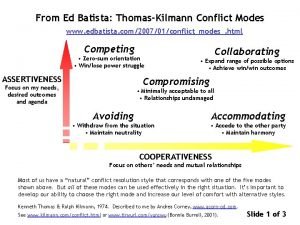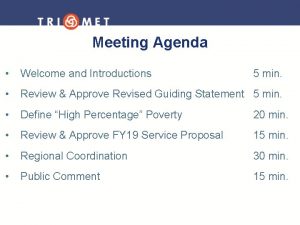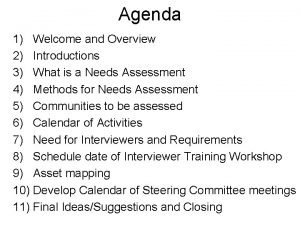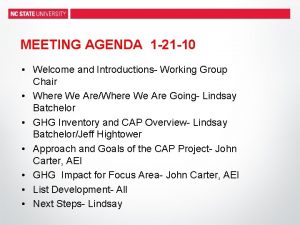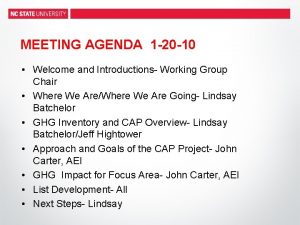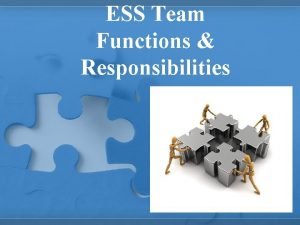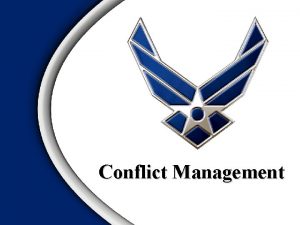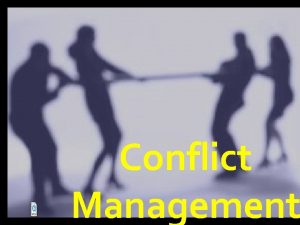Conflict Management Styles Conflict Management Styles Agenda Welcome

















- Slides: 17

Conflict Management Styles

Conflict Management Styles Agenda Welcome & Introductions Training Group Agreements/Ground Rules Review Training Goals Active Learning Training Reflections & Evaluation Closing

Conflict Management Styles Training Goals What is conflict Identify sources of conflict Understand your conflict management style Understand how relationships and challenges are addressed through different conflict styles Learn why it is important to resolve conflict

What is Conflict? Opposing ideas and actions of different people, resulting in an hostile/unfriendly state. A fight, battle, struggle, disagreement. . Some sources of conflict include: Discomforts Incidents Tension Misunderstandings Crisis

Conflict… Why is it important to understand how you manage conflict?

Understanding Conflict Management Styles SHARK OWL FOX TURTLE TEDDY BEAR

I N S T R U C T I O N S 1. Read each of the statements on the following pages. 2. Please circle A or B in each box for the statement that MOST represent you. 3. Each of these statements will apply to all of us some of the time; we are interested in knowing which of these statements represent you most of the time. 4. Use the scoring guide to tally your A and B answers based on the instructions on the guide. 5. The section with the highest number is your dominant conflict style.

Understanding Conflict Management Styles SHARK (Competing) • Is assertive and uncooperative. • Try to overpower others by forcing them to accept their solutions to the conflict. • Is an individual who pursues his/her own concerns at the other person’s expense using whatever power seems appropriate to win his/her position • Tactics such as attacking, overpowering, and intimidating others may be used. • Sharks assume conflicts are either won or lost and they want to be the winner. • Competing may also mean “standing up for your rights” or defending what you believe is correct.

Understanding Conflict Management Styles TEDDY BEAR (Accommodating) • Is unassertive and cooperative. • Relationships are very important, their own goals have little importance. • Give up their goals to preserve the relationship • There is an element of self-sacrifice in this style • May take the form of selfless generosity, obeying another person’s order when they prefer not to, or yielding to another’s point of view.

Understanding Conflict Management Styles TURTLE (Avoiding) • Is unassertive and uncooperative. • They withdraw into their shells to avoid conflict • They stay away from the conflicting issue and the person they are in conflict with. • They may sidestep or postpone an issue • Withdraw from a threatening situation • They believe it is easier to withdraw (physically and mentally) from a conflict than to face it.

Understanding Conflict Management Styles OWL (Collaborating) • Is assertive and cooperative. • Highly value their own goals and relationships. • Looks for solutions that fully satisfy the concerns of all parties • They don’t run from a conflict, they dig into it to find solutions that meet both party’s concerns. • They may explore disagreements to learn from each other’s insights and develop creative solutions.

Understanding Conflict Management Styles FOX (Compromising) • Is the middle stage in both assertiveness and cooperation. • Looks for practical, mutually acceptable solutions that partially satisfy the concerns of all parties • They seek solutions where both parties gain and will give up part of their goal and relationship in order to find agreement for the common good. • They address issues directly but may not explore the issue in great depth. • Compromising might mean splitting the difference or seeking a quick middleground position.

Approaches to Conflict High concern for issue/self (Our Way) (My Way) Low concern for Relationship High concern for Relationship (half way) (No Way) (Your Way) Low concern for issue/self

Why should you resolve conflict? To come to an agreement that benefits all parties. To understand more about those whose ideas, beliefs, and backgrounds may be different from your own. To ensure that your relationships with others continue and grow. To find peaceful solutions to difficult situations.

Training Reflections 1. Questions? 2. Please share 3 things you learned today

Training Evaluations Please complete the evaluation form on your table

THE END!
 Agenda sistemica y agenda institucional
Agenda sistemica y agenda institucional Turtle shark teddy bear fox owl test
Turtle shark teddy bear fox owl test Conflict management styles thomas kilmann
Conflict management styles thomas kilmann Agenda welcome and introductions
Agenda welcome and introductions Meeting agenda welcome and introductions
Meeting agenda welcome and introductions Agenda welcome and introductions
Agenda welcome and introductions Agenda welcome and introductions
Agenda welcome and introductions Agenda welcome and introductions
Agenda welcome and introductions Uhhshare
Uhhshare Agenda welcome and introductions
Agenda welcome and introductions Ess
Ess Meeting agenda welcome and introductions
Meeting agenda welcome and introductions Agenda welcome and introductions
Agenda welcome and introductions Welcome agenda
Welcome agenda Agenda welcome and introductions
Agenda welcome and introductions Agenda welcome and introductions
Agenda welcome and introductions Agenda welcome and introductions
Agenda welcome and introductions Agenda welcome and introductions
Agenda welcome and introductions


